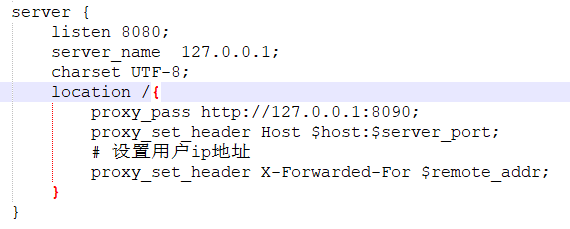应用场景
1、HTTP服务器
Nginx本身也是一个静态资源的服务器,当只有静态资源的时候,就可以使用Nginx来做服务器,如果一个网站只是静态页面的话,那么就可以通过这种方式来实现部署。
①文档目录创建路径如下:

②设置nginx.conf
http {
include mime.types;
default_type application/octet-stream;
sendfile on;
keepalive_timeout 65;
gzip on;
server {
listen 80;
charset UTF-8;
location /{
root D://com//static//;
index index.html;
}
}
}
③启动nginx(start nginx),访问地址:http://localhost/

④指令简介
◾server : 用于定义服务,http中可以有多个server块
◾listen : 指定服务器侦听请求的IP地址和端口,如果省略地址,服务器将侦听所有地址,如果省略端口,则使用标准端口
◾server_name : 服务名称,用于配置域名
◾location : 用于配置映射路径uri对应的配置,一个server中可以有多个location, location后面跟一个uri,可以是一个正则表达式, / 表示匹配任意路径, 当客户端访问的路径满足这个uri时就会执行location块里面的代码
◾root : 根路径,当访问http://localhost/test.html,“/test.html”会匹配到”/”uri, 找到root为/usr/local/var/www/html,用户访问的资源物理地址=root + uri = /usr/local/var/www/html + /test.html=/usr/local/var/www/html/test.html
◾index : 设置首页,当只访问server_name时后面不跟任何路径是不走root直接走index指令的;如果访问路径中没有指定具体的文件,则返回index设置的资源,如果访问http://localhost/html/ 则默认返回index.html
5、location uri正则表达式
◾. :匹配除换行符以外的任意字符
◾? :重复0次或1次
◾+ :重复1次或更多次
◾* :重复0次或更多次
◾d :匹配数字
◾^ :匹配字符串的开始
◾$ :匹配字符串的结束
◾{n} :重复n次
◾{n,} :重复n次或更多次
◾[c] :匹配单个字符c
◾[a-z] :匹配a-z小写字母的任意一个
◾(a|b|c) : 属线表示匹配任意一种情况,每种情况使用竖线分隔,一般使用小括号括括住,匹配符合a字符 或是b字符 或是c字符的字符串
◾ 反斜杠:用于转义特殊字符
小括号()之间匹配的内容,可以在后面通过$1来引用,$2表示的是前面第二个()里的内容。正则里面容易让人困惑的是转义特殊字符。
2、静态服务器
html
<h1>nginx index</h1>
<img src="20201030160749.jpg"></img>
<img src="nice.jpg"></img>
nginx.conf
http {
include mime.types;
default_type application/octet-stream;
sendfile on;
keepalive_timeout 65;
gzip on;
server {
listen 80;
charset UTF-8;
set $static_root D://com//static;
location /{
root D://com//static//;
index index.html;
}
location ~* .(gif|jpg|jpeg|png|bmp|ico|swf|css|js)$ {
root $static_root/image;
}
}
}

3、反向代理
反向代理应该是Nginx使用最多的功能了,反向代理(Reverse Proxy)方式是指以代理服务器来接受internet上的连接请求,然后将请求转发给内部网络上的服务器,并将从服务器上得到的结果返回给internet上请求连接的客户端,此时代理服务器对外就表现为一个反向代理服务器。
简单来说就是真实的服务器不能直接被外部网络访问,所以需要一台代理服务器,而代理服务器能被外部网络访问的同时又跟真实服务器在同一个网络环境,当然也可能是同一台服务器,端口不同而已。
反向代理通过proxy_pass指令来实现。
启动工程端口8090
访问地址:http://127.0.0.1:8090/
nginx.conf
http {
include mime.types;
default_type application/octet-stream;
sendfile on;
keepalive_timeout 65;
gzip on;
server {
listen 80;
charset UTF-8;
set $static_root D://com//static;
location /{
root D://com//static//;
index index.html;
}
location ~* .(gif|jpg|jpeg|png|bmp|ico|swf|css|js)$ {
root $static_root/image;
}
}
server {
listen 8080;
server_name 127.0.0.1;
charset UTF-8;
location /{
proxy_pass http://127.0.0.1:8090;
proxy_set_header Host $host:$server_port;
# 设置用户ip地址
proxy_set_header X-Forwarded-For $remote_addr;
}
}
}

访问:http://127.0.0.1:8080/
显示如下:

4、负载均衡
负载均衡也是Nginx常用的一个功能,负载均衡其意思就是分摊到多个操作单元上进行执行,例如Web服务器、FTP服务器、企业关键应用服务器和其它关键任务服务器等,从而共同完成工作任务。
简单而言就是当有2台或以上服务器时,根据规则随机的将请求分发到指定的服务器上处理,负载均衡配置一般都需要同时配置反向代理,通过反向代理跳转到负载均衡。而Nginx目前支持自带3种负载均衡策略,还有2种常用的第三方策略。
负载均衡通过upstream指令来实现。
nginx.conf
upstream web_servers {
server localhost:8090;
server localhost:8091;
}
server {
listen 80;
charset UTF-8;
location / {
proxy_pass http://web_servers;
# 必须指定Header Host
proxy_set_header Host $host:$server_port;
}
}
结果如下:

测试发现:
在火狐、ie、edge 中f5无效, ctrl+f5也是无效。
在chorme中F5无效,ctrl+f5有效。按一次就会请求到另一台服务器。
猜测可能是本地缓存的问题
支持多种负载均衡策略:默认轮询
①、轮询
②、权重
③、ip_hash
④、fair(第三方)
⑤、url_hash(第三方)
5、动静分离
动静分离是让动态网站里的动态网页根据一定规则把不变的资源和经常变的资源区分开来,动静资源做好了拆分以后,我们就可以根据静态资源的特点将其做缓存操作,这就是网站静态化处理的核心思路。
nginx.conf
upstream web_servers {
server localhost:8090;
server localhost:8091;
}
server {
listen 80;
charset UTF-8;
set $static_root D://com//static;
location ~* .(gif|jpg|jpeg|png|bmp|ico|swf|css|js)$ {
root $static_root/image;
}
location / {
proxy_pass http://web_servers;
# 必须指定Header Host
proxy_set_header Host $host:$server_port;
}
location /favicon.ico {
root D://com//static//image//;
}
}
html
<!DOCTYPE html>
<html>
<head>
<meta charset="utf-8">
<title>nginx教程222222222222222</title>
</head>
<body>
<h1>nginx教程2222222222222222222</h1>
<p>nginx教程2222222222222222222。</p>
<img src="logo.jpg"></img>
</body>
</html>
结果

6、其他
①.return指令
②.rewrite指令
重写URI请求 rewrite,通过使用rewrite指令在请求处理期间多次修改请求URI,该指令具有一个可选参数和两个必需参数。
第一个(必需)参数是请求URI必须匹配的正则表达式。
第二个参数是用于替换匹配URI的URI。
可选的第三个参数是可以停止进一步重写指令的处理或发送重定向(代码301或302)的标志
③.error_page指令
使用error_page指令,您可以配置NGINX返回自定义页面以及错误代码,替换响应中的其他错误代码,或将浏览器重定向到其他URI。在以下示例中,error_page指令指定要返回404页面错误代码的页面(/404.html)。
④.日志
⑤.deny 指令
⑥.内置变量
nginx的配置文件中可以使用的内置变量以美元符$开始,也有人叫全局变量。其中,部分预定义的变量的值是可以改变的。
◾$args :#这个变量等于请求行中的参数,同$query_string
◾$content_length :请求头中的Content-length字段。
◾$content_type :请求头中的Content-Type字段。
◾$document_root :当前请求在root指令中指定的值。
◾$host :请求主机头字段,否则为服务器名称。
◾$http_user_agent :客户端agent信息
◾$http_cookie :客户端cookie信息
◾$limit_rate :这个变量可以限制连接速率。
◾$request_method :客户端请求的动作,通常为GET或POST。
◾$remote_addr :客户端的IP地址。
◾$remote_port :客户端的端口。
◾$remote_user :已经经过Auth Basic Module验证的用户名。
◾$request_filename :当前请求的文件路径,由root或alias指令与URI请求生成。
◾$scheme :HTTP方法(如http,https)。
◾$server_protocol :请求使用的协议,通常是HTTP/1.0或HTTP/1.1。
◾$server_addr :服务器地址,在完成一次系统调用后可以确定这个值。
◾$server_name :服务器名称。
◾$server_port :请求到达服务器的端口号。
◾$request_uri :包含请求参数的原始URI,不包含主机名,如:”/foo/bar.php?arg=baz”。
◾$uri :不带请求参数的当前URI,$uri不包含主机名,如”/foo/bar.html”。
◾$document_uri :与$uri相同